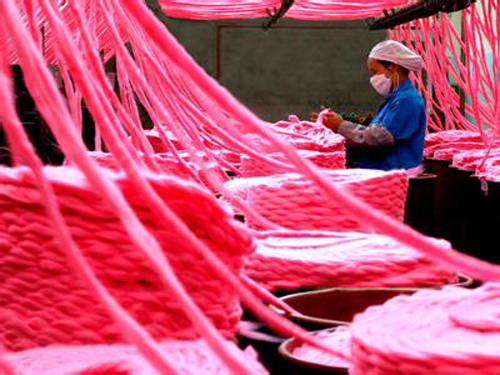Improvement of Export Warming Risk in Textile Industry Chain
Textiles and apparel: Exports are heating up to drive textile manufacturing out of the trough and garments are still in the adjustment period. Ladies Bottoms,Ladies Bottom Pants,Ladies Summer Shorts,Ladies Leisure Pants Polytex Co.,Ltd. Zhejiang , https://www.polytexchn.com
1) Industry risk characteristics.
China's textile and apparel are mainly located in manufacturing and low-end brand operations, and the overall situation is fully competitive. In addition to the domestic market, external demand is also a key factor affecting the industry's economy. The textile industry does not have bargaining power over the bulk of upstream raw materials, and its profitability is weak. In terms of financial performance, the overall size of the industry is relatively small, with weak profitability, moderate debt ratio, general liquidity, and low operating capacity. As a whole, the cross-cycle credit qualification of the textile and apparel industry is relatively poor.
2) Risks in the textile manufacturing industry: It has already come out of the bottom of the big cycle and it will take a long time for recovery.
With overseas demand picking up, the performance of the textile industry continued to rebound in the fourth quarter of 2012. Affected by the base effect in the first half of the year, both revenue and net profit growth were lower than the same period of last year. We believe that the textile industry has already reached the bottom of the major cycle, but the recovery may have to wait until 2015. Logic: 1) The policy of direct supplementation of Xinjiang cotton was introduced, and the short space was much longer. With the introduction of the direct supplement program, cotton will return to market pricing. After September-October new cotton was listed, the price of cotton still fell. 2) Downstream cotton spinning companies currently have a small demand for restocking, and are mainly in a state of purchase and use. Therefore, companies can reduce the adverse impact of falling cotton prices on gross profit through pricing changes and maintain stable profitability. 3) It is expected that the cotton price is expected to stabilize and rebound next year, driving the economic prosperity of the textile sector.
3) Clothing: Still in the contraction adjustment phase.
After going through inventory destocking in 2012-2013, starting from the end of 13 years, inventory has returned to the rising channel. Most of the companies are facing the difficult situation of traditional performance growth model supported by channels, future joining and self-operating, and the development path of online and offline collaboration is not yet clear, and the performance is still in the channel of decline as the market weakens. .
4) Textile manufacturing vouchers: Leading companies have a high margin of safety.
The textile industry basically has no premium ability to the upper reaches. The key point of profitability lies in cost control and upgrading of product structure. Therefore, the scale and technology of the enterprise are very important. The safety margin of leading enterprises is high. We recommend Weiqiao Venture Group, Weiqiao Textile, and Woolen Textile Group as the main reason. Nearly 50% of the revenue comes from photovoltaics and real estate, and the risk is high.
Chemical fiber - spandex, polyester.
1) The cross-cycle credit qualification of the chemical fiber industry is poor.
The chemical fiber industry as a whole has fierce competition, low product premium rates, and large macroeconomic impacts. The industry’s profitability and stability are weak, and cross-cycle credit quality is poor.
2) Spandex industry - The first half of the year was operating stably, and the medium-term economy continued to rise.
In 2013, the downstream demand for the spandex industry rebounded by about 30%. The year beginning of 2014 has been the spandex industry.
Smooth operation, market prices remained stable. The increase in the average price of spandex and raw material prices have weakened, and the profitability of the industry has rebounded. The future demand growth of the spandex industry is expected to remain at 7-10%, and the capacity will be put into use during 2014-2015. The supply and demand pattern in the medium term is relatively good.
3) Polyester industry: Long-term losses, cost declines, profitability, and economic growth.
The polyester industry has continued to lose money since 2012. Since the fourth quarter of last year, the demand in Europe and the United States has improved, and the growth rate of domestic new capacity has slowed down. The supply and demand structure of polyester industrial yarn continues to improve. In the short term, pta prices will remain low, and new production capacity in the polyester industrial silk industry will be limited. The polyester industry's business climate is expected to continue.
4) The vouchers are recommended by Huafeng Group and Hengyi Group.
Dyes - textile chemicals.
1) Higher cross-cycle credit quality in the industry.
2) In the first half of the year, oligopoly and environmental protection tightened the supply of disperse dyes to continue the boom. Environmental protection tightened the supply of hic acid, and h acid drove up the prosperity of active dyes.
3) The pattern of supply and demand of disperse dyes is reversed.
4) Downstream cost transfer supports the dye price increase space.
5) The prosperity of disperse dyes continues, and the price of reactive dyes is difficult to sustainably increase.
6) The vouchers recommended Zhejiang Longsheng and Chuanhua shares, but the valuation is less attractive.
risk warning.
Foreign demand for textile manufacturing picked up less than expected, cotton prices plummeted, and the domestic economy declined rapidly.